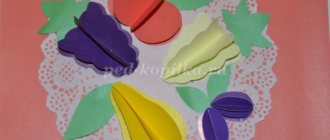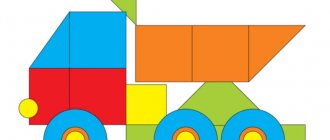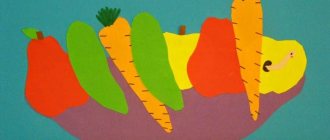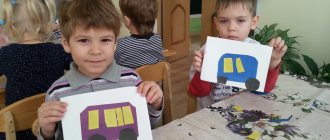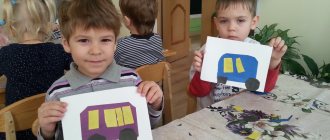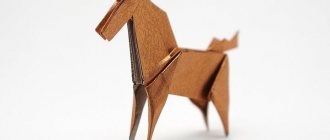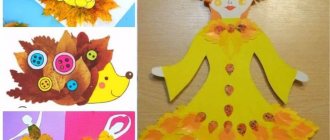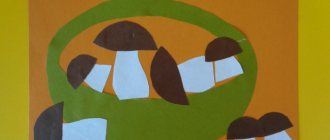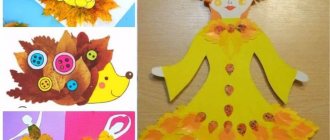The essence of the concept
Applique (from the Latin applicatio - application) is a type of visual technique in which an image is obtained by applying or attaching elements of paper, fabric or other material to a base that serves as the background for the picture.
According to the Federal State Educational Standard (FSES), in a preschool educational institution (DOU), application is an important element of children’s productive activities. Therefore, this type of visual technique must be mastered in kindergarten, regardless of the educational program on which the preschool educational institution operates. The only differences are in the form of presentation of this type of work. For example, if a kindergarten works according to the “Childhood” program, where all classes are grouped around a common theme in a certain period of time, then there will not be much thematic diversity in the applications, and therefore a wide range of mastery of techniques. A different situation is observed in preschool educational institutions working under the “Origins” program, where the different pace of psychological development of children is taken as a basis, and in this regard, a special role is given to the individualization of work with children, including through involvement in completing tasks together with their parents. For example, in the senior group, one of the tasks for an art project may be to prepare a project in the form of an application on the topic “Traffic Rules”.
Depending on the complexity of the application, the project can be short-term - up to a week, or long-term - up to a month
Goals of conducting classes on applications according to the Federal State Educational Standard
The mission of introducing this type of visual technology into the educational process of preschool educational institutions is:
- activation of fine motor skills - in younger groups this contributes to the rapid development of speech, and in older and preparatory groups it helps prepare the hand for writing;
- development of imaginative thinking (especially in the middle group, when kids begin to perform applications not only according to the model, but also based on their own ideas - the so-called tasks on “free topics”);
- developing the ability to work according to a model (in the younger group this helps expand the experience of children, and in the older group it accustoms them to the main form of work in elementary school);
- activation of the vocabulary (children replenish their vocabulary with new words and terms, for example, learn the meaning of words such as “pattern”, “plane image”, etc., and also practice the ability to formulate questions as they complete the task, develop the ability to give verbal evaluation of one’s own and others’ work);
- development of the ability to navigate in space and visual attention (kids practice placing parts exactly within the boundaries of the image contour, remembering the technique for doing this depending on the material - for example, placing a cut-out paper part is easier than “getting” into the boundaries of the contour with cut threads or grains);
- nurturing a positive attitude towards productive activities (regardless of the age group, in the process of work, children learn to solve emerging difficulties, focusing on obtaining the desired result, for example, if in the older group, in the process of completing an application on the topic “Bullfinch on a snow-covered branch,” a child had difficulties with gluing snow from cotton wool onto cardboard, it makes sense to try doing it with a different type of glue or “placing it” on double tape).
Appliqué work instills in children a positive attitude towards working in a team
Table: application tasks in preschool educational institutions for different age groups
| Group | List of tasks |
| First youngest |
|
| Second youngest |
|
| Average |
|
| Senior and preparatory |
|
Types of applications
Applique is a versatile technique that combines a huge number of different types or methods of making decorative images. Among them there are both widespread throughout the world and unique variants inherent in a particular culture and having a narrow geographical scope.
All types of applications can be classified according to the following criteria:
- Shape (volumetric or flat).
- Color (single or multi-color).
- Subject (subject, plot, decorative or abstract).
- Scope of application (for interior items, household utensils, furniture, clothing, shoes).
- Purpose (illustration, for decoration, updating the appearance or repairing a creative object).
- Material (from fabric, beads, paper, leather, fur, clay, straw, leaves, fluff, shells, cereals, buttons, threads, yarn, pieces of wood).
- Type of base (on cardboard, fabric, wood, paper, glass, plastic).
- Fastening method (sewn and glued).
- Style (vintage, country, modern, military, high-tech, ethno).
Applique has much in common with other popular arts and crafts techniques: decoupage and inlay. All of them are designed to decorate interior items, but differ in their characteristic features.
Inlay is the technique of finishing hard surfaces of a base with the same hard pieces of materials: wood, metal, artificial and natural stone, ivory, pearls. It is used to decorate the facades of buildings, interior spaces and pieces of furniture (tables, chairs, chests, chests of drawers, cabinets).
Decoupage is a type of decoration technique in which decoration elements glued to the base are additionally coated with a thick layer of varnish. Transparent film reliably protects the decor from the negative effects of moisture and temperature changes. The decoupage technique is used not only in conjunction with appliqué and inlay, but also when creating relief icons, dishes, and picture frames.
Application as a topic for teacher self-education
Self-education is an important means of teacher professional development. In the practice of preschool educational institutions, topics on self-education affect all (!) areas of the educational process. Including the development of children within the framework of the artistic and aesthetic direction of the educational process. In this context, teachers study the possibilities of various visual techniques in realizing the teaching, developmental and educational goals of preschool education. In this sense, the application opens up a wide field for activity, since:
- has many types;
- practiced from the first junior group;
- can be used in classes of any direction (FEMP, speech development, FCCM, etc.);
- allows you to solve several educational problems at once (for example, children develop spatial thinking, logic, fine motor skills, creativity, etc.).
As for building a scheme for working on a self-education topic related to an application, it remains unchanged and includes three stages:
- theoretical (study of methodological literature on the topic);
- practical (implementation of theory in practical activities);
- reporting (summarizing, drawing up reports - printed, photo and video).
In the process of implementing the practical stage of mastering the topic, the teacher applies theoretical knowledge, and this combination is analyzed in the report on the work done
Approximate list of topics for self-education on application
There are topics of a more general nature, and there are more specific ones:
- “Development of creative abilities in preschool children using applications.”
- “Non-traditional techniques of visual activities (applications) in kindergarten.”
- “Appliqué as a means of developing fine motor skills of children of primary school age.”
- “Development of fine motor skills in children of older different age groups in visual activities (applications).”
- “Non-traditional materials in appliqué as a means of artistic expression for children.”
Application as a type of artistic activity for a preschooler
Olesya Cherkashina
Application as a type of artistic activity for a preschooler
Application as a type of artistic activity for preschoolers.
Plan
1. The essence and meaning of the application for a preschooler. Types of applications.
2. The originality of applications in preschool age.
3. Features of application materials and techniques for working with them.
4. Objectives of training and development of children (junior, middle, senior, preparatory groups).
5. Features of methods and techniques for teaching children applications in different age groups.
1).
The concept of “application”, its types and techniques
Applique is the simplest and most accessible way to create artwork, which preserves the realistic basis of the image itself. This makes it possible to widely use appliqué not only for design purposes (in the production of visual aids, manuals for various games, toys, flags, souvenirs for holidays, design of wall newspapers, exhibitions, nursery rooms, but also in the creation of paintings, ornaments, etc. d.
Application - can be substantive, consisting of individual images (leaf, branch, tree, mushroom, flower, bird, house, person, etc.); plot, reflecting a set of actions, events (“Victory Salute”, “Flight into Space”, “The Birds Have Arrived”, etc.); decorative, including ornaments and patterns that can be used to decorate various objects.
Kinds
In object appliqué, children master the ability to cut out images from paper and paste individual objects onto the background, which, due to the specific nature of the activity, convey a somewhat generalized, even conventional image of surrounding objects or their representations in toys, pictures, and examples of folk art.
At the initial stage, kids lay out and glue an object from parts prepared by the teacher: a ball - two halves of different colors; a fungus - a cap and a leg; trolley - rectangular body and round wheels; garland - rectangular flags, etc.
Plot-thematic application
assumes the ability to cut out and paste various objects in interaction in accordance with the theme or plot (“Chicken pecking grains”, “Kolobok is resting on a stump”, “Fish are swimming in an aquarium”, “Rooks are making nests in a tree”). In this case, the child faces the following tasks:
- cut out objects, show their differences in size when compared with each other (tall tree and small rooks, large and small fish);
- highlight the main objects, the main characters, connect them with the scene of action, the setting (fish swim in an aquarium, flowers grow in a meadow). The main thing stands out in size, color, compositional placement among other objects;
convey the characteristic features of the characters and their actions through gestures, posture, clothing, coloring (the bun met the bear - the figures are glued in the position of turning towards each other);
arrange objects on the plane of the bases: on one line in a row horizontally and vertically, indicating the height of the objects (a street in our city, a cheerful round dance); create two-plane compositions - lower, higher, weakening the color, reducing the size of objects taking into account their distance (boats at sea, a flowering meadow with a strip of forest in the distance);
select and appropriately use color and its combinations to convey the time of year, weather conditions, attitude to the depicted object and phenomena (golden autumn, winter in the forest, harvesting).
Decorative applique -
a type of ornamental activity during which children master the ability to cut out and combine various elements of decoration (geometric plant forms, generalized figures of birds, animals, humans) according to the laws of rhythm, symmetry, using bright color comparisons. In these classes, the child learns to stylize and decoratively transform real objects, generalize their structure, and endow samples with new qualities.
2). The originality of applications in preschool age.
Appliqué is one of children’s favorite types of visual arts: children are delighted with the bright color of the paper, the successful rhythmic arrangement of the figures, and the technique of cutting and pasting is of great interest to them.
In appliqué classes, special emphasis should be placed on the organization of examination of objects offered for depiction. An examination is a process of perceiving an object organized by a teacher, which consists in the fact that the teacher, in a strictly defined sequence, identifies the aspects and properties of the object that children must learn in order to then successfully carry out the image process. In the process of such perception, children form clear ideas about those properties and qualities of objects that are important for the image (about the shape, size, structure and color of the object). We need to teach children to perceive. They cannot master this process on their own. Shape, structure, color, first of all, are perceived visually, so objects are first examined.
All the methods and techniques used for teaching appliqué in the classroom are combined and interact, providing a better understanding and assimilation of the material, and the development of children's visual creativity.
Applique is the simplest and most accessible way to create artwork, which preserves the realistic basis of the image itself. This makes it possible to widely use appliqué not only for design purposes (in the production of visual aids, manuals for various games, toys, flags, souvenirs for holidays, design of wall newspapers, exhibitions, nursery rooms, but also in the creation of paintings, ornaments, etc. d.
3). Features of application materials and techniques for working with them.
The most interesting and accessible for preschool children is applique paper made of bright colors.
The paper for the background is most often taken thick, the tone is selected depending on the content of the image in order to emphasize a certain situation. For example, flowers are placed against a green background of a clearing or meadow, silhouettes of birds are pasted against a blue background of the sky, and fish are pasted against the background of the blue depths of a river or sea.
Children cut out applique elements from more elastic, but resilient paper in rich, rich tones with a well-treated surface.
For work, the child is given scissors with rounded ends and designed levers. Their length should be approximately 120 mm. Brushes for smearing figures cut out of paper are taken depending on the size of the workpieces. So, for collective application you need to have brushes of two sizes. For gluing large surfaces, use wide flat brushes called flute brushes.
The figures are smeared with glue on a clean mat. This could be a small sheet of white paper. During the lesson, it must be changed several times so that the paste does not stain the colored side of the applications and does not leave unwanted stains.
4). Tasks of learning and development of children (junior, middle, senior, preparatory groups).
The following general tasks are solved in application training:
Create a decorative pattern from various geometric shapes and plant (leaf, flower) details, placing them in a certain rhythm on a cardboard or fabric base of various shapes.
Compose an image of an object from separate parts; depict the plot.
Master various techniques for obtaining parts for appliqué from different materials: cutting with different techniques, tearing, weaving; as well as the technique of attaching them to the base: gluing, sewing.
Develop a sense of color, know primary colors and their shades, master the ability to create harmonious color combinations.
Develop a sense of form, proportion, composition.
The objectives and content of application training are specified taking into account the accumulation of experience and development of the child.
Introduction to the application begins with the first junior group. The teacher is guided by a well-known characteristic of children: at the age of 2-3 years, healthy children have a pronounced emotional response to an offer to do something, to participate in something, the child shows a readiness to act. And the main task of an adult is to support this activity, not to let it fade away, to give it a creative character. This favorable period of childhood for the development of children's activity and independence should not be missed. The tasks solved at this age are elementary:
Give kids an idea of the necessary tools and equipment for appliqué: scissors, brush, glue, oilcloth, etc.
Develop emotional responsiveness to an adult’s offer to do something, a willingness to participate with him in the creation of basic artistic crafts.
Develop interest, an emotionally positive attitude towards basic actions with paper, and the desire to carry them out independently.
Develop aesthetic perception and feelings: recognize the resulting image, admire, rejoice “following” adults.
Mastering specific actions with materials, tools, and objects at an early age occurs through communication with an adult. Only he can convey to the child information about the functions of objects, tools, show methods of using material, etc. in joint activities with him.
1. Teach children to make patterns from geometric shapes on a strip, square, rectangle, isosceles triangle.
2. Teach preschoolers to make simple objects from ready-made shapes (a Christmas tree, a house, a snowman, etc., and elementary plots from familiar objects (a train with a trailer, a house with a Christmas tree, etc.).
3. Teach children to hold scissors correctly, cut narrow strips along the fold (bent in half, and then wider ones (several strokes of the scissors).
Teach the technique of spreading paper parts with glue: “outlining” its edges with a brush with glue.
4. To form in children a conscious attitude to the order in which work is performed: first lay out the pattern (object, plot) on a sheet of paper, and then take and stick each detail one by one.
5. To develop artistic taste in preschoolers.
5). Features of methods and techniques for teaching children applications in different age groups.
The first manual productive actions, joint with an adult, included in the context of creating a certain “product,” emotionally prepare the child for systematic and more meaningful participation in the application. The first attempts to transform the material do not require children to clearly perceive shape and color; they are not yet involved in the design of the image, but already in the fourth year of life, more complex tasks can be set in the application:
In middle preschool age, the child’s hand becomes firmer and more confident, so more complex cutting methods appear; children themselves can make details such as an oval, a circle, rounding the corners of rectangles; cutting corners in a straight line to make a trapezoid; cut the squares diagonally to create triangles. Children of this age can be given stencils to cut out details of subject content (mushroom, flower, etc.). Experience shows that children who have worked with a stencil and cut out parts along the contour later have an easier time mastering symmetrical and silhouette cutting and cutting “by eye.”
If children master scissors early, then by the end of middle age they can cut out parts from fabric using all the above methods, and as a result, fabric appliqué is possible. For the base, burlap, drape, and plain-dyed cotton fabric are used. You can make patterns on it either by alternating parts of different colors and shapes, or by creating compositions from elements of national ornaments of different peoples, you can create an object or elementary plot appliqué. But unlike similar paper products, appliqué on fabric is more durable and versatile in use (napkin, towel, carpet, tablecloth).
Children four to five years old can be taught appliqué from dry plant leaves: to create a pattern, alternating leaves by shape, size, color and placing them symmetrically on a cardboard base of different geometric shapes: stripes, squares, etc.
You cannot smear the sheet with glue, like a piece of paper or fabric, by moving the brush along the contour - the sheet will begin to crumble. It is spread by moving the brush from the index finger of the left hand to the edges of the sheet.
To convey the image to children, other materials are provided: pencils, thin twigs, seeds. For example, when making a butterfly applique, the abdomen can be made not only from a leaf, but also drawn and glued on a thin twig; for the eyes, use small seeds or draw them too.
In older preschool age, children master more complex cutting techniques - symmetrical, silhouette, multi-layered, as well as tearing and weaving techniques. They can combine techniques.
Preschoolers are learning new ways to attach parts: sewing them to fabric. In this case, children receive two options for the image: planar and semi-volumetric (when cotton wool is placed between the base and the part). In the second case, the image is more expressive. A semi-volume applique is also obtained by partially gluing parts, for example, only the middle of a snowflake, flower, butterfly, etc.
Systematic teaching of children various methods of applique from various materials creates the basis for the creative expression of a preschooler in independent activities: he can choose the content of the applique (decorative pattern, object, plot, material (one or more in combination) and use different techniques suitable for more expressive execution planned.
Junior preschool age
Art [/u] is a period when the formation of all organs and systems of the body proceeds at a very rapid pace. Therefore, it is very important to lay the foundations for full development in a timely manner.
The specificity of the application gives children the opportunity to more actively acquire knowledge about color, the structure of objects, their size, planar shape and composition. The applique allows you to move cut out shapes and compare them by placing one shape on top of another.
Game-activities are carried out with a subgroup of five to six children. Under the guidance of a teacher, children learn to arrange figures in a certain order, compose an image of an object from two or three parts, and correlate them by shape, color, size, and spatial location.
The main goal of these exercises is to instill in children an interest in actions with cut-out figures, to arouse a desire to independently make some objects out of them, to create the simplest combinations, to form sensory experience, to enrich knowledge about surrounding objects and the means of their figurative transmission.
Game techniques are ways of jointly (teacher and children) developing a plot-based game plan by setting game tasks and performing appropriate game actions aimed at teaching and developing children.
In appliqué classes, special emphasis should be placed on the organization of examination of objects offered for depiction. An examination is a process of perceiving an object organized by a teacher, which consists in the fact that the teacher, in a strictly defined sequence, identifies the aspects and properties of the object that children must learn in order to then successfully carry out the image process. In the process of such perception, children form clear ideas about those properties and qualities of objects that are important for the image (about the shape, size, structure and color of the object). We need to teach children to perceive. They cannot master this process on their own. Shape, structure, color, first of all, are perceived visually, so objects are first examined. To clarify such properties of objects as volumetric shape, size, quality of the surface of the material (roughness, smoothness), along with viewing and feeling - tactile perception is required. Therefore, along with appliqué classes, classes are held to familiarize children with the properties of paper.
The developmental features of children of this age indicate the need to organize repetitive actions and exercises in the learning process. They are necessary both for better mastery of certain skills by children, and for accelerating awareness and voluntariness in activities. In this regard, classes with a small subgroup of children turned out to be quite effective, where the children were first asked to act individually, and then perform the same actions and operations together on a common sheet of paper or flannelgraph, and vice versa.
The use of the reproductive method in these cases contributed to the formation in children of conscious and voluntary actions associated with the analytical process of cognition.
The research method is effective in creating educational situations that encourage children to conduct independent search activities and find a way to complete a task through trial and error.
The use of the research method encouraged children to actively search. The children acted independently by comparing and contrasting and achieving the desired result. The research method is also used when the teacher invites children to complete creative tasks or create images according to their own ideas.
The gaming technique is predominant in organizing applique classes with children of primary preschool age. In fact, the playful nature of learning permeates the entire educational process. Children are offered travel around the city, into the forest, using different types of transport; dramatizations, walking stories, during which they meet with different representatives of the animal and plant world, game characters, etc.
All the methods and techniques used for teaching appliqué in the classroom are combined and interact, providing a better understanding and assimilation of the material, and the development of children's visual creativity.
The classes carried out pursued different goals, but in each of them the children were given the role of an active participant, while the kids were imperceptibly involved in the activities that were offered to them. Some of the classes, especially at later stages, were aimed at developing basic teamwork skills, gaining experience in joint actions, and encouraging active communication with other children and adults.
Thus, work experience has shown that with directed pedagogical guidance, application classes contribute to more intensive development of all aspects of the personality.
Literature:
1. Krupskaya N.K. About preschool education. Collection of articles and speeches. M., 1973, p. 71.
2. “Methods of teaching visual activity and design,” ed. N. P. Sakulina, T. S. Komarova; M., 1979
3. Methodological recommendations for the “Program of education and training in kindergarten” (compiled by L. V. Ruskova) - M.: Education, 1986.
4. Panteleeva L.V. et al. Artistic work in kindergartens of the USSR and SFRY: A book for kindergarten teachers (L.V. Panteleeva, E. Kamenov, M. Stanoevich. - M.: Prosveshchenie, 1987.
Literature on applications to help teachers
To facilitate the process of preparing application classes, the teacher can use the following sources:
- Gribovskaya A.A. Application in kindergarten, - M.: Scriptorium, 2010.
- Grigorieva G.G. Visual activities of preschool children. - M.: Publishing House, 1997;
- Gusakova M.A. Application, - M.: “Enlightenment”, 1982;
- Korotkova E.A. Drawing and application in kindergarten, - M.: Academy of Development, Harvest, 2009;
- Methods of visual activity and design classes / edited by T.S. Komarova, - M.: “Enlightenment”, 1985;
- Methods of teaching drawing, modeling and application in kindergarten / edited by Sakkulina N.P. – M.: “Enlightenment”, 1971;
- Novikova I.V. Volumetric application in kindergarten, - M.: 2011;
- Pogateeva Z.A. Applique classes in kindergarten, - M.: “Prosveshcheniye”, 1988;
- Rumyantseva E.A. Application. Simple crafts, - M.: World of Books, 2010.
- Sakkulina N.P., Komarova T.S. Visual activities in kindergarten, - M.: “Prosveshchenie”, 1982.
Application in kindergarten occupies a special place in the educational process, as it allows you to realize the important goals of the educational process in a preschool educational institution, on the one hand, and on the other hand, children are involved in this type of work with great pleasure - the process of making picture elements even fascinates them more than a focus on getting results. From the position of a teacher, the application, among other things, also opens up wide opportunities for developing topics for self-education.
Let's consider the specific features of using different teaching methods in appliqué classes in different age groups of kindergarten.
Middle group . In the middle group, partial demonstration of techniques for completing a task is often used. For example, when cutting and sticking a house, what is new for children is the ability to cut off the corners of the strip representing the roof. The teacher, having disassembled the sample, only shows how to cut out the roof. Children complete the rest of the details according to the model.
A demonstration of the entire image process is carried out in the case of particularly complex images (for example, when gluing a truck from separate parts).
In all cases when the work techniques are familiar to the children, the teacher either gives a partial demonstration or only explains the task, giving them the opportunity to independently choose the image techniques.
Particular attention in this group requires training in the correct use of scissors. This is the first complex instrument that falls into the hands of children. The teacher shows several times in what position the fingers of the right hand, holding the scissors, and the left, in which the paper is located, should be; move the scissors levers properly so that the paper is cut and not wrinkled. To make the first attempts easier, children are given paper in the form of narrow strips (3-4 cm wide), which are cut with two movements of scissors.
It is better to carry out the first exercises with scissors with a subgroup of children of 8-10 people, so that you can easily monitor the actions of each child and help in time.
At the end of the lesson, the teacher, together with the children, analyzes whether the application was made correctly (resembles the object or not), whether the forms are carefully glued (clean background, no traces of glue are visible). Children always take an active part in discussing work. The teacher summarizes the children’s assessments, sums up the lesson, drawing attention to successful work.
Senior group. The main task of teaching appliqué to children of the sixth year of life is to master a variety of cutting techniques. In classes, preschoolers depict objects with different shapes, symmetrical and asymmetrical shapes in a static position or conveying simple movement.
Based on the children's ideas and using nature (or a picture replacing it), the teacher analyzes the structure of the object, isolating individual parts, outlining their forms and noting their relationships with each other.
The sample is used in the older group in cases where preschoolers depict an object for the first time. But even here, children should be given the initiative in resolving issues of color, size, arrangement of shapes on the sheet, etc.
If children are given the task of depicting an already familiar object with some details, then the sample can be replaced by life or a picture (for example, depict not just a house, but a fairy-tale house or a house decorated for a holiday).
In the senior, and then in the preparatory groups, it is recommended to use several samples more often to show the possibility of different composition options. This fosters creative initiative in preschoolers in completing tasks. For example, children learn the technique of cutting out two halves of Parsley's costume from two pieces of paper folded together. The teacher only shows techniques for cutting out clothes, and when looking at the samples, the children note that Petrushka’s clothes can be of different colors, shapes, and he has different objects in his hands. In decorative works, when making patterns from the same elements, paper in the shape of a circle, square, strip, etc. is used.
As a rule, older preschoolers master new techniques based on the teacher’s demonstration.
The most difficult thing for children of this age is cutting out symmetrical shapes from paper folded in half. Mastering this technique requires developed perception and analytical thinking, in particular, the ability to divide an object into two halves and cut it out.
I.L. Gusarova recommends that when children are first introduced to this technique, they cut out shapes along a pre-drawn outline on paper folded in half. Often a child cannot imagine that the result will be a beautifully shaped vase or jug. When children realize that the drawn outline represents half of the object, they will be able to cut it out by eye, using the teacher’s demonstration and explanation.
In the older group, some application works (for example, “Aquarium with fish”, “Flowers in the meadow”, “Houses and cars on the street”) are performed by children collectively. Each child performs a specific part of the composition. All parts are subsequently united against a common background.
The teacher distributes work among children in accordance with their wishes.
Preparatory group . New to the program material in this group is silhouette cutting. In this regard, the nature of the use of various teaching methods is changing.
When analyzing nature, the teacher draws children's attention to the features of the contour of the object, tracing it with his finger. You can invite children to do the same. Tracing the outline should begin with the part of the object from which cutting will then begin.
Children in the older group carved simple objects (vegetables, fruits). In the preparatory group for school, it is envisaged to make appliqués from objects, the outline of which includes any details (fins on a fish, needles on a hedgehog, etc.).
Since it is difficult for preschoolers to simultaneously concentrate on creating a general outline and cutting out small details, they should be shown a method that consists of two stages: first, a generalized shape is cut out from a pre-prepared piece of paper of appropriate sizes, and then details (needles and legs) are cut out along the edge of this shape hedgehog, fin and tail of a fish).
Pre-K children learn more advanced cutting techniques from folded paper. First, they consolidate the skills they acquired in the senior group when cutting out shapes from paper folded in half. As tasks they offer more complex symmetrical shapes - a Christmas tree, animals, people. When preparing the shape of a Christmas tree for appliqué, you should show how to preserve its cone-shaped structure: a rectangle bent in half is cut diagonally, and then the branches of the resulting triangle, also bent in half, are cut out along the edge. This technique can only be used in the preparatory group, since six-year-old children can proceed in constructing an image from the general to the specific and from the specific back to the general. A more complex cutting technique - from paper folded several times - is used to make napkins, snowflakes, and flowers. The sample in this group is not used for copying, but to clarify the task. Therefore, it may not provide a complete image, but may look like a diagram. For example, when performing decorative appliqué on a sample, the location of the pattern elements is marked with conventional signs. Children, using this scheme, create a pattern, selecting elements as they wish.
In the preparatory group, plot appliqué classes continue. New for children is maintaining consistency in the arrangement and gluing of forms. Unlike a drawing, where the sequence of spatial arrangement of objects can be different, in appliqué the sequence of arrangement and gluing of forms is always strictly defined: first the general background (sky, earth), then objects in the background, middle and foreground.
Older preschoolers already understand that objects can block each other, so they will be partially visible in the application. In this case, the sample is used only to explain the technique, and the task is completed without a sample, based on the children’s ideas.
The implementation of plot applications in the preparatory group can be organized as collective work, with preschoolers distributing the work among themselves without the help of a teacher. For example, when illustrating episodes from “The Tale of Tsar Saltan” by A. S. Pushkin, children are united in groups of 4 people. Each group performs appliqué on one of the scenes from the fairy tale; The distribution of plots between groups is carried out by the teacher, and the children independently decide who will cut out and decorate the barrel, who - clouds and stars, who - waves, etc. When all the shapes are cut out and distributed on the sheet, the children decide in what sequence they should be stick. Together, the children attach the forms to the paper: some spread them with glue, others place them in place, others press them with a cloth, etc. Such collective work is valuable because, on the one hand, it fosters feelings of collectivism and camaraderie, and on the other, it contributes to the formation ability to plan and think through the entire course of work in advance.
